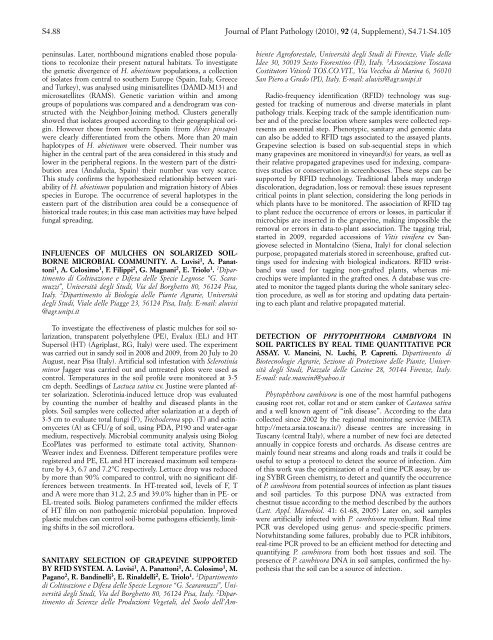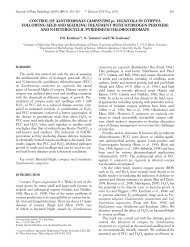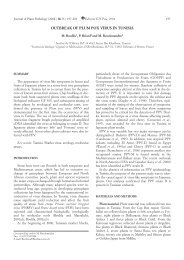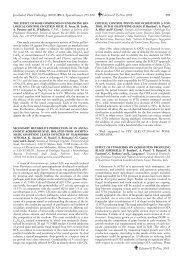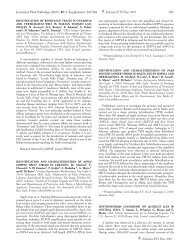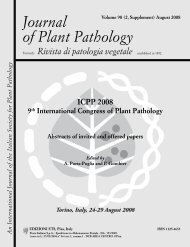Journal of Plant Pathology (2010), 92 (4, Supplement ... - Sipav.org
Journal of Plant Pathology (2010), 92 (4, Supplement ... - Sipav.org
Journal of Plant Pathology (2010), 92 (4, Supplement ... - Sipav.org
Create successful ePaper yourself
Turn your PDF publications into a flip-book with our unique Google optimized e-Paper software.
S4.88 <strong>Journal</strong> <strong>of</strong> <strong>Plant</strong> <strong>Pathology</strong> (<strong>2010</strong>), <strong>92</strong> (4, <strong>Supplement</strong>), S4.71-S4.105<br />
peninsulas. Later, northbound migrations enabled those populations<br />
to recolonize their present natural habitats. To investigate<br />
the genetic divergence <strong>of</strong> H. abietinum populations, a collection<br />
<strong>of</strong> isolates from central to southern Europe (Spain, Italy, Greece<br />
and Turkey), was analysed using minisatellites (DAMD-M13) and<br />
microsatellites (RAMS). Genetic variation within and among<br />
groups <strong>of</strong> populations was compared and a dendrogram was constructed<br />
with the Neighbor-Joining method. Clusters generally<br />
showed that isolates grouped according to their geographical origin.<br />
However those from southern Spain (from Abies pinsapo)<br />
were clearly differentiated from the others. More than 20 main<br />
haplotypes <strong>of</strong> H. abietinum were observed. Their number was<br />
higher in the central part <strong>of</strong> the area considered in this study and<br />
lower in the peripheral regions. In the western part <strong>of</strong> the distribution<br />
area (Andalucìa, Spain) their number was very scarce.<br />
This study confirms the hypothesized relationship between variability<br />
<strong>of</strong> H. abietinum population and migration history <strong>of</strong> Abies<br />
species in Europe. The occurrence <strong>of</strong> several haplotypes in the<br />
eastern part <strong>of</strong> the distribution area could be a consequence <strong>of</strong><br />
historical trade routes; in this case man activities may have helped<br />
fungal spreading.<br />
INFLUENCES OF MULCHES ON SOLARIZED SOIL-<br />
BORNE MICROBIAL COMMUNITY. A. Luvisi 1 , A. Panattoni<br />
1 , A. Colosimo 1 , F. Filippi 2 , G. Magnani 2 , E. Triolo 1 . 1 Dipartimento<br />
di Coltivazione e Difesa delle Specie Legnose “G. Scaramuzzi”,<br />
Università degli Studi, Via del B<strong>org</strong>hetto 80, 56124 Pisa,<br />
Italy. 2 Dipartimento di Biologia delle Piante Agrarie, Università<br />
degli Studi, Viale delle Piagge 23, 56124 Pisa, Italy. E-mail: aluvisi<br />
@agr.unipi.it<br />
To investigate the effectiveness <strong>of</strong> plastic mulches for soil solarization,<br />
transparent polyethylene (PE), Evalux (EL) and HT<br />
Supersol (HT) (Agriplast, RG, Italy) were used. The experiment<br />
was carried out in sandy soil in 2008 and 2009, from 20 July to 20<br />
August, near Pisa (Italy). Artificial soil infestation with Sclerotinia<br />
minor Jagger was carried out and untreated plots were used as<br />
control. Temperatures in the soil pr<strong>of</strong>ile were monitored at 3-5<br />
cm depth. Seedlings <strong>of</strong> Lactuca sativa cv. Justine were planted after<br />
solarization. Sclerotinia-induced lettuce drop was evaluated<br />
by counting the number <strong>of</strong> healthy and diseased plants in the<br />
plots. Soil samples were collected after solarization at a depth <strong>of</strong><br />
3-5 cm to evaluate total fungi (F), Trichoderma spp. (T) and actinomycetes<br />
(A) as CFU/g <strong>of</strong> soil, using PDA, P190 and water-agar<br />
medium, respectively. Microbial community analysis using Biolog<br />
EcoPlates was performed to estimate total activity, Shannon-<br />
Weaver index and Evenness. Different temperature pr<strong>of</strong>iles were<br />
registered and PE, EL and HT increased maximum soil temperature<br />
by 4.3, 6.7 and 7.2°C respectively. Lettuce drop was reduced<br />
by more than 90% compared to control, with no significant differences<br />
between treatments. In HT-treated soil, levels <strong>of</strong> F, T<br />
and A were more than 31.2, 2.5 and 39.0% higher than in PE- or<br />
EL-treated soils. Biolog parameters confirmed the milder effects<br />
<strong>of</strong> HT film on non pathogenic microbial population. Improved<br />
plastic mulches can control soil-borne pathogens efficiently, limiting<br />
shifts in the soil micr<strong>of</strong>lora.<br />
SANITARY SELECTION OF GRAPEVINE SUPPORTED<br />
BY RFID SYSTEM. A. Luvisi 1 , A. Panattoni 1 , A. Colosimo 1 , M.<br />
Pagano 2 , R. Bandinelli 3 , E. Rinaldelli 2 , E. Triolo 1 . 1 Dipartimento<br />
di Coltivazione e Difesa delle Specie Legnose “G. Scaramuzzi”, Università<br />
degli Studi, Via del B<strong>org</strong>hetto 80, 56124 Pisa, Italy. 2 Dipartimento<br />
di Scienze delle Produzioni Vegetali, del Suolo dell’Am-<br />
biente Agr<strong>of</strong>orestale, Università degli Studi di Firenze, Viale delle<br />
Idee 30, 50019 Sesto Fiorentino (FI), Italy. 3 Associazione Toscana<br />
Costitutori Viticoli TOS.CO.VIT., Via Vecchia di Marina 6, 56010<br />
San Piero a Grado (PI), Italy. E-mail: aluvisi@agr.unipi.it<br />
Radio-frequency identification (RFID) technology was suggested<br />
for tracking <strong>of</strong> numerous and diverse materials in plant<br />
pathology trials. Keeping track <strong>of</strong> the sample identification number<br />
and <strong>of</strong> the precise location where samples were collected represents<br />
an essential step. Phenotypic, sanitary and genomic data<br />
can also be added to RFID tags associated to the assayed plants.<br />
Grapevine selection is based on sub-sequential steps in which<br />
many grapevines are monitored in vineyard(s) for years, as well as<br />
their relative propagated grapevines used for indexing, comparatives<br />
studies or conservation in screenhouses. These steps can be<br />
supported by RFID technology. Traditional labels may undergo<br />
discoloration, degradation, loss or removal: these issues represent<br />
critical points in plant selection, considering the long periods in<br />
which plants have to be monitored. The association <strong>of</strong> RFID tag<br />
to plant reduce the occurrence <strong>of</strong> errors or losses, in particular if<br />
microchips are inserted in the grapevine, making impossible the<br />
removal or errors in data-to-plant association. The tagging trial,<br />
started in 2009, regarded accessions <strong>of</strong> Vitis vinifera cv Sangiovese<br />
selected in Montalcino (Siena, Italy) for clonal selection<br />
purpose, propagated materials stored in screenhouse, grafted cuttings<br />
used for indexing with biological indicators. RFID wristband<br />
was used for tagging non-grafted plants, whereas microchips<br />
were implanted in the grafted ones. A database was created<br />
to monitor the tagged plants during the whole sanitary selection<br />
procedure, as well as for storing and updating data pertaining<br />
to each plant and relative propagated material.<br />
DETECTION OF PHYTOPHTHORA CAMBIVORA IN<br />
SOIL PARTICLES BY REAL TIME QUANTITATIVE PCR<br />
ASSAY. V. Mancini, N. Luchi, P. Capretti. Dipartimento di<br />
Biotecnologie Agrarie, Sezione di Protezione delle Piante, Università<br />
degli Studi, Piazzale delle Cascine 28, 50144 Firenze, Italy.<br />
E-mail: vale.mancini@yahoo.it<br />
Phytophthora cambivora is one <strong>of</strong> the most harmful pathogens<br />
causing root rot, collar rot and or stem canker <strong>of</strong> Castanea sativa<br />
and a well known agent <strong>of</strong> “ink disease”. According to the data<br />
collected since 2002 by the regional monitoring service (META<br />
http://meta.arsia.toscana.it/) disease centres are increasing in<br />
Tuscany (central Italy), where a number <strong>of</strong> new foci are detected<br />
annually in coppice forests and orchards. As disease centres are<br />
mainly found near streams and along roads and trails it could be<br />
useful to setup a protocol to detect the source <strong>of</strong> infection. Aim<br />
<strong>of</strong> this work was the optimization <strong>of</strong> a real time PCR assay, by using<br />
SYBR Green chemistry, to detect and quantify the occurrence<br />
<strong>of</strong> P. cambivora from potential sources <strong>of</strong> infection as plant tissues<br />
and soil particles. To this purpose DNA was extracted from<br />
chestnut tissue according to the method described by the authors<br />
(Lett. Appl. Microbiol. 41: 61-68, 2005) Later on, soil samples<br />
were artificially infected with P. cambivora mycelium. Real time<br />
PCR was developed using genus- and specie-specific primers.<br />
Notwhitstanding some failures, probably due to PCR inhibitors,<br />
real-time PCR proved to be an efficient method for detecting and<br />
quantifying P. cambivora from both host tissues and soil. The<br />
presence <strong>of</strong> P. cambivora DNA in soil samples, confirmed the hypothesis<br />
that the soil can be a source <strong>of</strong> infection.


